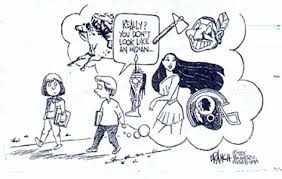In the modern day of 2017, so much of our lives are spent online. We as people have the universe at our fingertips – with so much information out there, what all can be considered trustworthy? An issue with the concept of Mass Media is that anything and everything can be found somewhere online. Anyone who is able to access the internet is able to contribute their information and knowledge. Like moths to a flame, we are instantly bound to the first bit of information we see and accept it as fact. This leads to many issues spanning across many topics. In the past few years, the concept of “Cultural Appropriation” has exploded across everywhere and everything. To be correct when describing, defining, or demonstration any form of culture is so incredibly vital that issues arise when someone does this incorrectly. With it being so easy to misappropriate a culture in Media, what are we able to trust and how does the mass media change our perception of different cultures through their ideas of appropriation?
Native American culture is found in the roots of this country’s foundation. Often, when considering American history we forget that America was populated BEFORE 18th century colonization. The culture of Native Americans is one that has been appropriated for hundreds of years, through music, art, dance, etc. Because of this, our concept of this culture has been warped by pop culture and media as demonstrated in this cartoon…
This cartoon presents the problem of misappropriation. This boy only identifies “Indians” as the overly stereotypical form displayed in movies, sports teams, or cartoons. To him, this girl who looks “normal” doesn’t fit that stereotype and thus he questions her cultural authenticity.
Another example of this kind of appropriation occurs in cartoons. One example in particular is in Seth Macfarlane’s TV cartoon comedy “Family Guy”. In the episode The Life of Brian the episode begins with Stewie and Brian running from a band of Indians in a modern day city. They explore and make racist remarks about their ways of transportation, medicine, clothing, and music.
https://www.youtube.com/watch?v=PGcW3kjcFSU
These two clips, both from the same episode, demonstrate the racist humor that Macfarlane is demonstrating. Examples like having the doctor at the hospital stand in a bunch of poses to try to cure disease, using smoke signals instead of phones, and having their most popular song be mono-tonal unison chanting are prime examples of Native American Appropriation. This kind of appropriation Macfarlane uses can even be found in other forms of music, such as Dvorak Symphony No 9 movement 2, largo. In this movement he references Native American tribal melodies. Of course, what he notates is only a small, itemized fraction of what the actual melody would have been and what it was to represent. Was Dvorak trying specifically to be incorrect, probably not, but still – some find this use of melody an unfair representation of the true culture.
In 2017, being able to rid our minds of ignorance and to be able to fully understand and be aware of the sensitivities of other cultures is imperative. The massed media and pop culture has shaped our minds around what being a Native American or an “Indian” means. These stereotypes are preventing us as a nation from knowing the rich and long history of Native Americans and their culture. As Russell Means says in this video: “A nation that does not know its history, has no future”
Sources
Kanke, Marie. “The Harm of Native Stereotyping.” Blue Corn Comics — The Harm of Native Stereotyping: Facts and Evidence. August 08, 2006. Accessed September 25, 2017. http://www.bluecorncomics.com/stharm.htm.
TheUlleberg. “Family guy – Native American/Indian Radio.” YouTube. March 07, 2014. Accessed September 25, 2017. https://www.youtube.com/watch?v=octtLcjJshw.
Jinpaul11. “Family Guy – Native Americans.” YouTube. May 07, 2017. Accessed September 25, 2017. https://www.youtube.com/watch?v=PGcW3kjcFSU.
Diesillamusicae. “Dvořák: Symphony №9, “From The New World” – II – Largo.” YouTube. September 02, 2011. Accessed September 26, 2017. https://www.youtube.com/watch?v=ASlch7R1Zvo.
Framesinmotion2007. “How Hollywood stereotyped the Native Americans.” YouTube. October 31, 2007. Accessed September 25, 2017. https://www.youtube.com/watch?v=_hJFi7SRH7Q.

You’re thinking through some really big questions, and I’m overjoyed to see that. As I mentioned in class, I expect to see you add primary sources from the assigned collections – and there’s no need to wait for your next post. Any chance you could find an example of appropriation or a documented example of someone else’s appropriation in one of the collections from this past Tuesday? (Spoiler alert: yes, yes there is a chance.)
You’re right to draw Family Guy into this conversation, but it’s not clear to me that what Seth MacFarlane is doing counts as “appropriation” so much as it’s “representation.” The line between the two can be blurry, but I read the episode you embedded as a parody of parodies – a parody of the ridiculous representations of Native Americans that we’ve seen in film, literature, art, and music for the past few centuries. You get the sense that Seth MacFarlane absolutely knows better, and that he isn’t so much poking fun at the Indians as at the white kid in your comic who doesn’t realize that Indians are as “normal” and, in some ways, as unremarkable as anyone else.